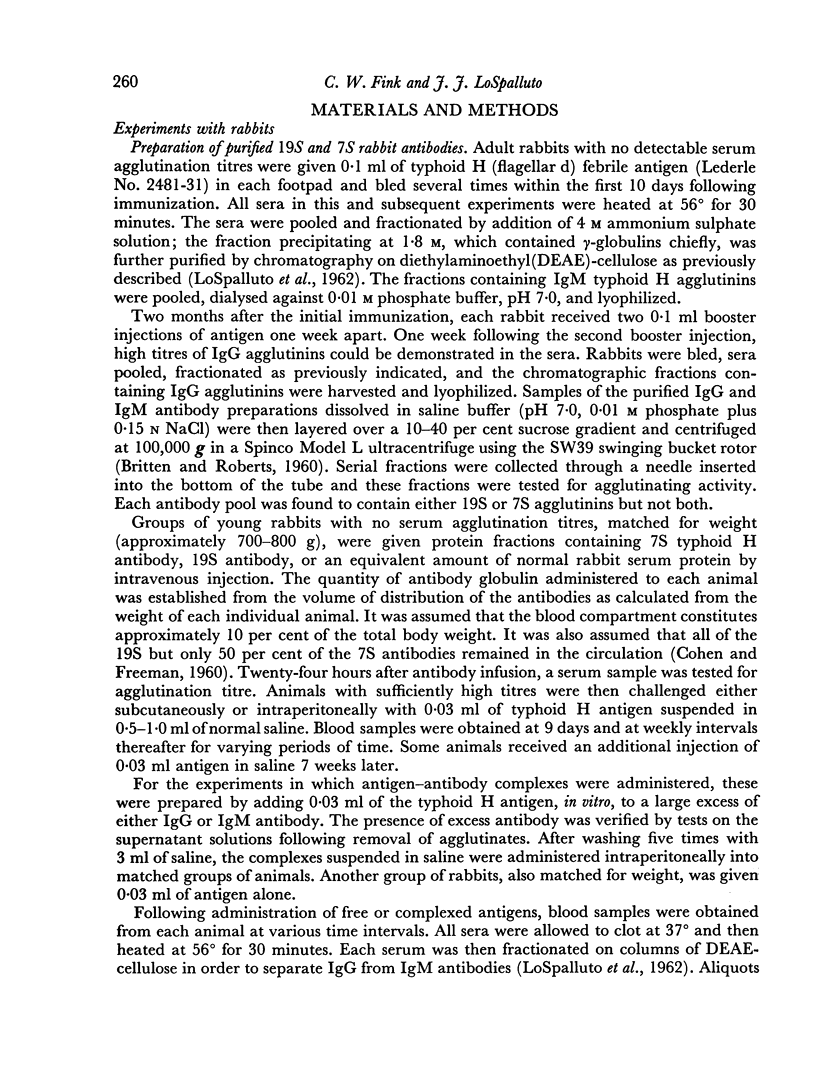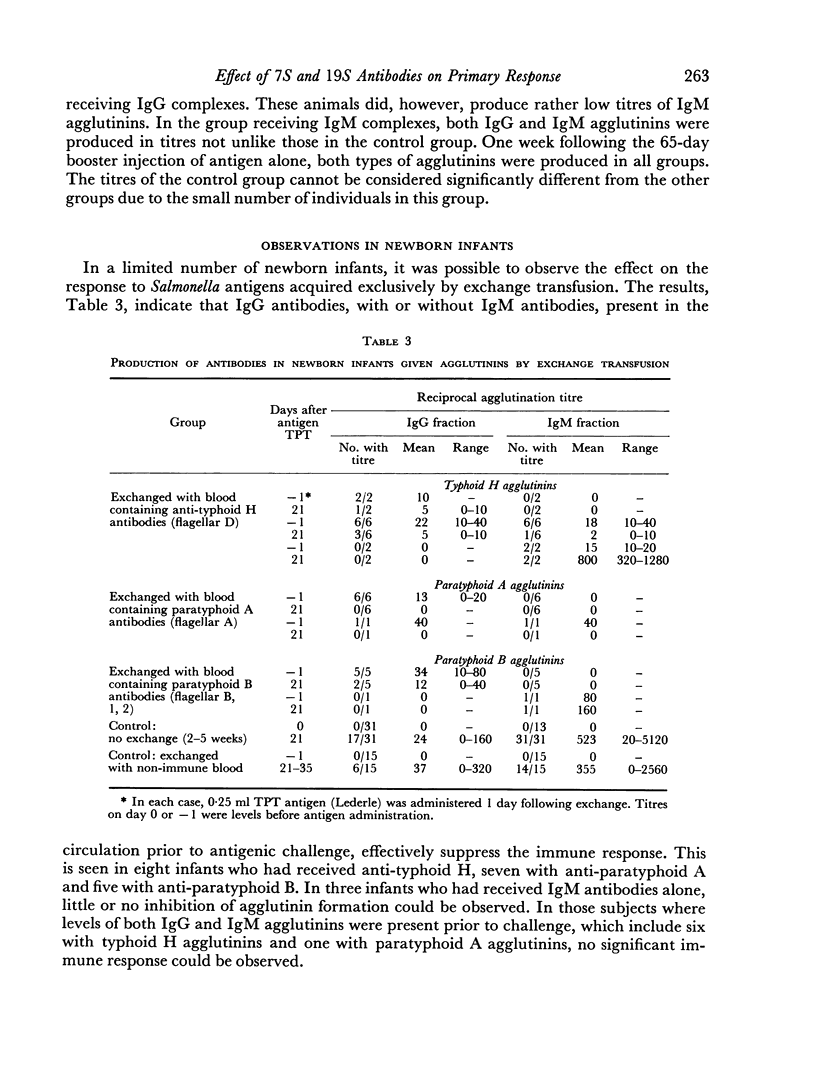Abstract
The effect of IgM and IgG antibodies on the primary response to Salmonella typhi antigen has been studied. IgG antibodies given before antigenic challenge or combined with antigen in antibody excess profoundly suppressed the formation of agglutinins in rabbits and humans. IgM antibodies appeared to have little or no inhibitory effect when given as complexes in antibody excess or when infused in relatively small amounts. Larger amounts do inhibit agglutinin formation in rabbits. It is suggested that the antibodies exert their inhibitory effect by combining with antigen and removing it as a stimulant for antibody formation.
Full text
PDF







Selected References
These references are in PubMed. This may not be the complete list of references from this article.
- Britten R. J., Roberts R. B. High-Resolution Density Gradient Sedimentation Analysis. Science. 1960 Jan 1;131(3392):32–33. doi: 10.1126/science.131.3392.32. [DOI] [PubMed] [Google Scholar]
- COHEN S., FREEMAN T. Metabolic heterogeneity of human gamma-globulin. Biochem J. 1960 Sep;76:475–487. doi: 10.1042/bj0760475. [DOI] [PMC free article] [PubMed] [Google Scholar]
- COHEN S. PROPERTIES OF THE PEPTIDE CHAINS OF NORMAL AND PATHOLOGICAL HUMAN GAMMA GLOBULINS. Biochem J. 1963 Nov;89:334–341. doi: 10.1042/bj0890334. [DOI] [PMC free article] [PubMed] [Google Scholar]
- EISEN H. N., SISKIND G. W. VARIATIONS IN AFFINITIES OF ANTIBODIES DURING THE IMMUNE RESPONSE. Biochemistry. 1964 Jul;3:996–1008. doi: 10.1021/bi00895a027. [DOI] [PubMed] [Google Scholar]
- FINK C. W., MILLER W. E., Jr, DORWARD B., LOSPALLUTO J. The formation of macroglobulin antibodies. II. Studies on neonatal infants and older children. J Clin Invest. 1962 Jul;41:1422–1428. doi: 10.1172/JCI104597. [DOI] [PMC free article] [PubMed] [Google Scholar]
- FINKELSTEIN M. S., UHR J. W. SPECIFIC INHIBITION OF ANTIBODY FORMATION BY PASSIVELY ADMINISTERED 19S AND 7S ANTIBODY. Science. 1964 Oct 2;146(3640):67–69. doi: 10.1126/science.146.3640.67. [DOI] [PubMed] [Google Scholar]
- LOSPALLUTO J., MILLER W., Jr, DORWARD B., FINK C. W. The formation of macroglobulin antibodies. I. Studies on adult humans. J Clin Invest. 1962 Jul;41:1415–1421. doi: 10.1172/JCI104596. [DOI] [PMC free article] [PubMed] [Google Scholar]
- OSBORN J. J., DANCIS J., JULIA J. F. Studies of the immunology of the newborn infant. II. Interference with active immunization by passive transplacental circulating antibody. Pediatrics. 1952 Sep;10(3):328–334. [PubMed] [Google Scholar]
- ROBBINS J. B., KENNY K., SUTER E. THE ISOLATION AND BIOLOGICAL ACTIVITIES OF RABBIT GAMMA M- AND GAMMA G-ANTI-SALMONELLA TYPHIMURIUM ANTIBODIES. J Exp Med. 1965 Aug 1;122:385–402. doi: 10.1084/jem.122.2.385. [DOI] [PMC free article] [PubMed] [Google Scholar]
- SAHIAR K., SCHWARTZ R. S. INHIBITION OF 19S ANTIBODY SYNTHESIS BY 7S ANTIBODY. Science. 1964 Jul 24;145(3630):395–397. doi: 10.1126/science.145.3630.395. [DOI] [PubMed] [Google Scholar]
- SVEHAG S. E., MANDEL B. THE FORMATION AND PROPERTIES OF POLIOVIRUS-NEUTRALIZING ANTIBODY. I. 19S AND 7S ANTIBODY FORMATION: DIFFERENCES IN KINETICS AND ANTIGEN DOSE REQUIREMENT FOR INDUCTION. J Exp Med. 1964 Jan 1;119:1–19. doi: 10.1084/jem.119.1.1. [DOI] [PMC free article] [PubMed] [Google Scholar]
- SVEHAG S. E., MANDEL B. THE FORMATION AND PROPERTIES OF POLIOVIRUS-NEUTRALIZING ANTIBODY. II. 19S AND 7S ANTIBODY FORMATION: DIFFERENCES IN ANTIGEN DOSE REQUIREMENT FOR SUSTAINED SYNTHESIS, ANAMNESIS, AND SENSITIVITY TO X-IRRADIATION. J Exp Med. 1964 Jan 1;119:21–39. doi: 10.1084/jem.119.1.21. [DOI] [PMC free article] [PubMed] [Google Scholar]
- UHR J. W., BAUMANN J. B. Antibody formation. I. The suppression of antibody formation by passively administered antibody. J Exp Med. 1961 May 1;113:935–957. doi: 10.1084/jem.113.5.935. [DOI] [PMC free article] [PubMed] [Google Scholar]
- UHR J. W., DANCIS J., FRANKLIN E. C., FINKELSTEIN M. S., LEWIS E. W. The antibody response to bacteriophage phi-X 174 in newborn premature infants. J Clin Invest. 1962 Jul;41:1509–1513. doi: 10.1172/JCI104606. [DOI] [PMC free article] [PubMed] [Google Scholar]
- UHR J. W., FINKELSTEIN M. S. Antibody formation. IV. Formation of rapidly and slowly sedimenting antibodies and immunological memory to bacteriophage phi-X 174. J Exp Med. 1963 Mar 1;117:457–477. doi: 10.1084/jem.117.3.457. [DOI] [PMC free article] [PubMed] [Google Scholar]


